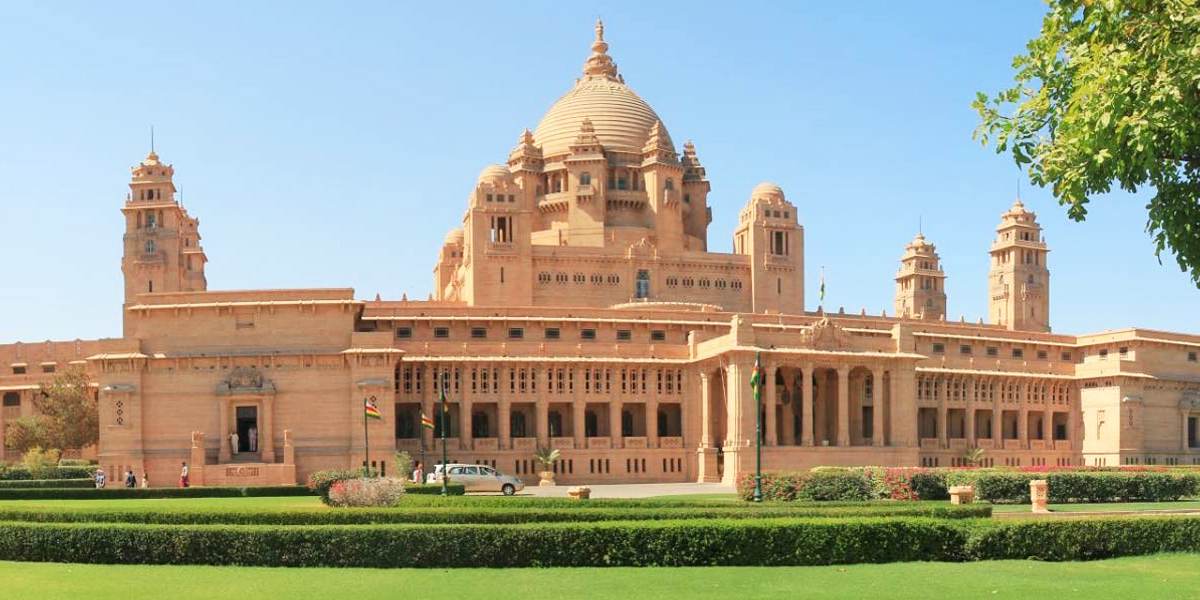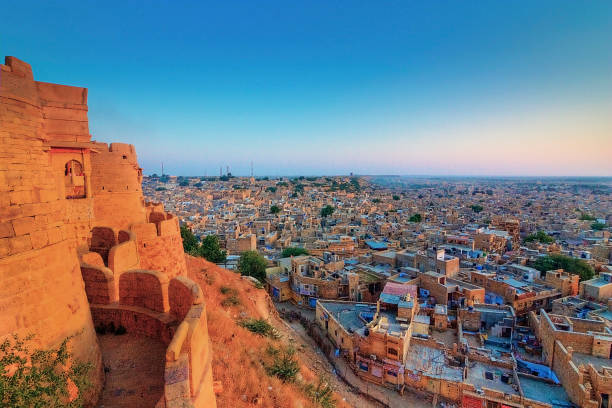Umaid Bhawan Palace in Jodhpur
The magnificent Umaid Bhawan Palace in Jodhpur, one of the world’s largest private residences is a golden hued desert sandstone monument set amidst acres of verdant gardens.

Umaid Bhawan Palace is the largest private residence in the world. There are 372 rooms, wood-panelled library, private museum, indoor swimming pool, billiards room, tennis courts and unique marble squash courts. All these things make Umaid Bhawan Palace one of the most magnificent structures in the city.
The iconic structure was named after Maharaja Umaid Singh, the last king of what was known as the Marwar-Rathore Dynasty. It was built to provide employment to thousands of people during the time of famine in the 1920s. Now a home to the erstwhile Jodhpur Royal Family, it has one thing in common with the iconic Taj Mahal of Agra— the Makrana marble that is used in its construction. Built on sprawling grounds of 26 acres of lush grounds including 15 acres of well-manicured gardens, it was the last palace to be built before independence.
The main attractions of Umaid Bhawan includes a collection of vintage cars, clocks and banners gifted by Queen Victoria, artefacts belonging to the royals, cutleries, trophies and weapons.
Due to which, villager faces many harmful consequences in Jodhpur village. The great saint also predicts the future of Jodhpur in a good mean. The restoration will help to establish the new Dynasty if we talk about the main challenges facing by the villager.
For those three years, farmers of that area are not able to grow crops on their food, and Village is suffering from the shortage of food and water. Then, the 37th Rathore ruler comes Marwar in Jodhpur to provide some self-employment so they can survive in harsh conditions.
To help the farmer, the king decided to build a lavish Palace which is very famous nowadays with the name of Umaid Bhawan Palace in Jodhpur. The King or Maharaja Umaid Bhawan consecrates with Henry Vaughan Lanchester to prepare the architecture of the palace.
After that, Lanchester plain to built this Umaid palace, which based on the line of New Delhi building complex. He was adopting the theme of domes and columns. Finally, the Design of Umaid Bhawan palace was ready for execution with western technology and Indian architectural features.
Umaid Bhawan Palace in Jodhpur Rajasthan is a brilliant example of remarkable constructions. Moreover, now it’s a five star luxurious hotel where one can have a royal stay with all modern comforts.
Acquiring an area up to 26 acres of land, the royal mansion is 110 ft high and showcases sumptuous rooms reflecting a rich bygone era. It is one among the most expensive hotels in Jodhpur. The regal palace constitutes of elegant royal heirlooms, high ceilings, marble corridors, treasure troves, hunting trophies, green velvet lawns and courtyards. The interiors of the palace were firstly designed by Maples of London in Art Deco style, but later, the ship carrying the stuff to Bombay was sunk by Germans in 1942. Afterwards, Maharaja Umaid Singh himself bought a polished artist namely Stefan Norblin who was an interior decorator and was familiar with the style of Art deco.
The beautifully designed paintings and furnishings done by Stefan are still well-preserved here. It is the India’s last royal constructions. Moreover, out of total 26 acres of land, fifteen acres comprises of sprawling gardens, its central cupola, a ball room, a library, indoor swimming, billiards room, four tennis courts, 105 ft Darbar hall for audience, a marble pavilion, a nursery, garages that can park twenty motor cars and two marble squash courts.
Other than this, the grand mansion also comprises a unique clock tower, Durbar hall for public gathering, Edwardian drawing room, banquet, cinema hall, a private segment for ladies and billiards room. During its constructions, Umaid Bhawan was the most awaited palace for the’ Maharaos of Kotah’; as before they used to live in a small fort inside the same city. Thus, Umaid Sigh decided to build this noble one to comfort the Maharao’s.
Later, in 1930, the palace was extended by the architect George Devon, in order to provide space for Maharaj Kumar Bhim Singh and his wife. This section is still reserved and is not open for public, though, rest of the palace is considered to be the private residence as a heritage hotel. Similar to that of other royal Rajput mansions, Umaid Bhawan palace also has a Mardana section for male and a Zenana section for females with separate entrances.
The museum has exhibits of stuffed leopards, a very large symbolic flag gifted to Maharaja Jaswant Singh by Queen Victoria in 1877, an impressive “quirky” collection of clocks in windmill and light house shapes, and photographs of the elegant art-deco interior of the palace. The classic cars of the Maharajas are also on display in the garden in front of the museum. Glass, porcelain wares, memorabilia, and information on the building of the palace are also part of the exhibits. The Darbar Hall, which is part of the museum, has elegant murals and also substantial number of miniature paintings, armour and an unusual collection of household paraphernalia that was in vogue in the 1930s, which were costly and then not found in India. So visit it.
Entry fee for Indians – INR 25 per head; INR 30 for museum for adults and INR 10 for children
Entry fee for foreigners – INR 50 per head; INR 100 per head for museum.
